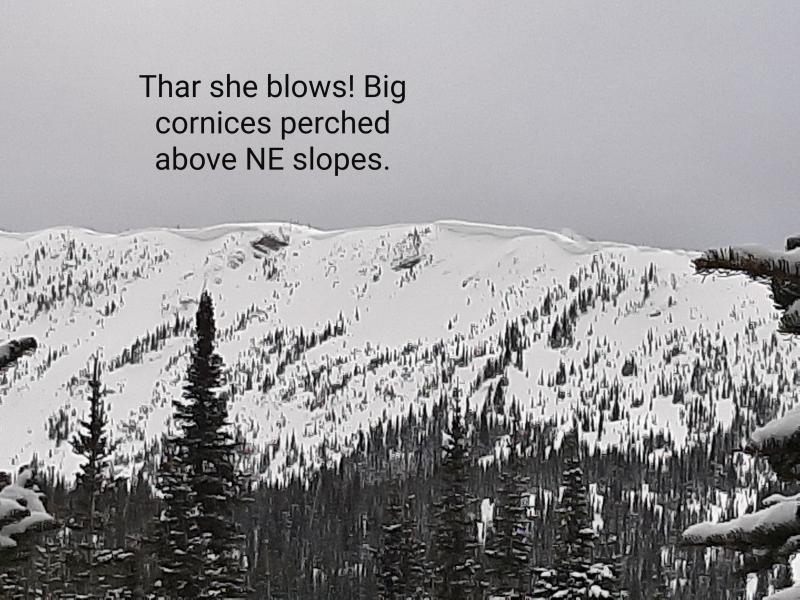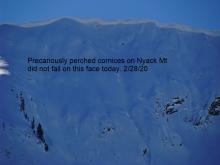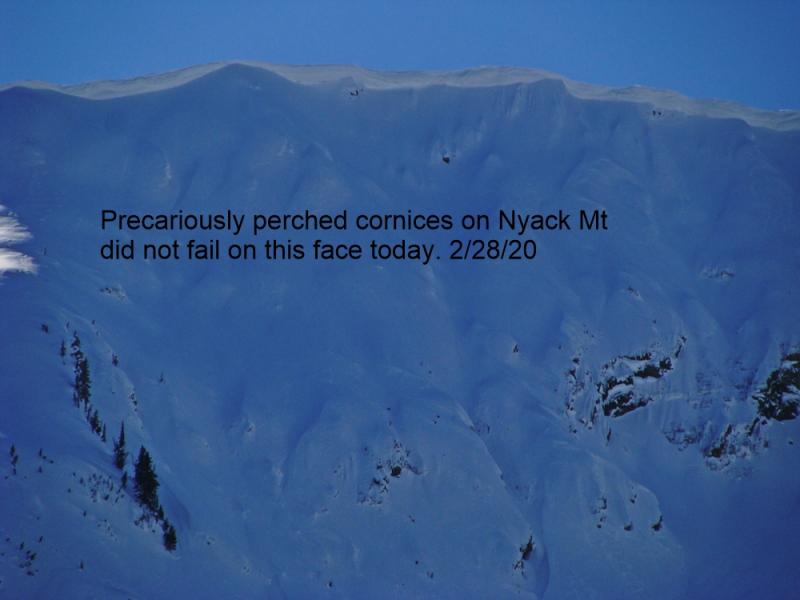| Friday | Friday Night | Saturday | |
|---|---|---|---|
| Cloud Cover: | Mostly clear with warm temperatures. High clouds in the afternoon/evening. | Snow showers begin late/early morning. | Continued rain/snow with lowering snow levels. |
| Temperatures: | 39-52 deg. F. | 27-33 deg. F. | 37-45 deg. F. |
| Wind Direction: | S-SW | S-SW | W-SW |
| Wind Speed: | 7-8 gusts 18 | 7-8 gusts 21-23 | 13-16 gusts 28-35 |
| Snowfall: | 0 in. | 0 in. | 0-2 in. |
| Snow Line: |
Whitefish Range
Swan Range
Flathead Range and Glacier National Park
How to read the forecast
The avalanche danger is MODERATE on wind loaded slopes. Human triggered avalanches are possible. Carefully evaluate recently formed wind slabs for lingering instability. In other terrain the danger is LOW. Pay attention to rising temperatures and sun exposed slopes today. The danger will rise to MODERATE on sunny aspects as the day progresses. Move to more shaded terrain when the snow surface becomes moist.

2. Moderate
?
Above 6500 ft.
2. Moderate
?
5000-6500 ft.
1. Low
?
3500-5000 ft.
- 1. Low
- 2. Moderate
- 3. Considerable
- 4. High
- 5. Extreme
-
Type ?
-
Aspect/Elevation ?
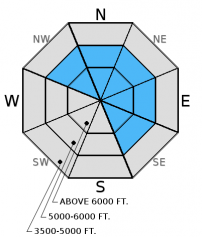
-
Likelihood ?CertainVery LikelyLikelyPossible
 Unlikely
Unlikely -
Size ?HistoricVery LargeLargeSmall

Winds earlier in the week drifted the recent storm snow and created wind slabs on leeward slopes and cross-loaded mid-elevation terrain. These wind slabs continue to gain strength but lingering instabilities exist. Due to limited data from many of our weather stations, fresh wind slab development cannot be ruled out. It can take up to a week for these slabs to strengthen so continue to carefully evaluate all wind loaded terrain before committing to a slope. Look for rounded pillows of wind drifted snow on leeward sides of ridges and cross-loaded areas in gullies at both mid and upper elevations.
-
Type ?
-
Aspect/Elevation ?
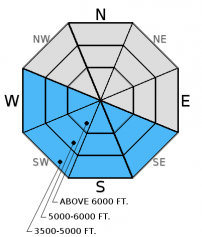
-
Likelihood ?CertainVery LikelyLikelyPossible
 Unlikely
Unlikely -
Size ?HistoricVery LargeLargeSmall

Clear skies last night allowed temperatures to drop below freezing at all elevations producing a hard freeze of the snow surface. However, the warmest temperatures of the week are expected today and with continued sunshine, the loose wet avalanche danger will rise on sunny aspects at all elevations. Early signs that the surface snow is becoming unstable are roller balls and pinwheels on steep slopes and cut banks. Pay attention to these changing conditions and move to more shaded terrain when the snow surface becomes moist.
-
Type ?
-
Aspect/Elevation ?

-
Likelihood ?CertainVery LikelyLikelyPossible
 Unlikely
Unlikely -
Size ?HistoricVery LargeLargeSmall

Large cornices exist throughout the advisory area. These cornices can fail naturally during periods of warming. The weight of a cornice failure can trigger an avalanche on the slope below. With sunshine and warming temperatures on tap for today cornices will weaken and cornice fall will be possible. Remember that cornices can pull out farther behind the ridgeline than expected so it is important to give them a wide buffer when traveling above.
This season we dealt with an ever evolving persistent slab problem associated with widespread rain crusts and weak snow surrounding these crusts. As time has passed so has our concern with some of these rain crusts. Currently, we are still tracking the strength of the snow around the January 28 and February 14 crusts. The Valentine's Day crust now has 1.5-3 feet of snow sitting on top of it. In recent observations we found a thin layer of facets above this crust. Keep in mind that even small avalanches can step down into this deeper layer.
As our mid winter snowpack transitions into a spring snowpack glide cracks are beginning to form. On Monday we observed a recently formed glide crack in the Kimmerly Basin area of the southern Whitefish Range, and others have reported isolated areas with glide cracks (observation). Glide avalanches are notoriously difficult to predict. It is best to simply avoid slopes with glide crack present (photo).
Thursday: We skied into Wahoo Creek in the Flathead Range. With nearly perfect visibility we could see many of the surrounding peaks and noted recently wind loaded and cross loaded slopes, as well as large cornices along leeward ridgelines. The snow surface was moist by afternoon on sunny slopes and we saw a few small, loose, wet avalanches and rollerballs. It was interesting that as we skied into mid-elevation terrain that the recent wind slabs were more firm and slightly more reactive than up high.
Wednesday: Skiers in the southern Whitefish Range reported widespread surface hoar development, new glide cracks that have formed and minimal solar affect on sunny aspects (observation, observation).
Tuesday: Snowmobilers in the Stahl Peak area in the northern Whitefish Range observed recent avalanche activity within the past 4 days. One slide was suspected to be machine triggered (observation). BNSF Avalanche Safety noted active wind loading in southern Glacier Park yesterday. Two separate parties of skiers in the Middle Fork corridor observed substantial wind loading at upper elevations (photo) while skiers in the northern Swan Range reported calm winds at ridgetop locations.
Monday: We traveled to Kimmerly Basin in the southern Whitefish Range where we found cohesive snow on wind loaded aspects. While skiing on this snow we observed localized cracking and were able to initiate small wind slab avalanches. We also noted large cornice development with numerous small cornice failures and a large glide crack (observation). Snowmobile observers traveled to Red Meadow in the northern Whitefish Range and Werner Peak in the southern Whitefish Range. They found evidence of recent wind loading and wind slab avalanches (observation).
Sunday: Snowmobilers in the Lost Johnny drainage of the northern Swan Range noted a large natural slab avalanche that appears to have been triggered by a cornice fall (observation). Skiers in Spider Bowl in the northern Swan Range noted lots of sluffing of the new snow on steep upper elevation slopes, southerly aspects becoming sun affected as the day progressed and only minimal new snow on a crust at 5000 feet. Skiers in the Marion Lake area of the Flathead Range reported south facing slopes being sun affected with a 1/2 inch thick crust by late afternoon but good snow quality and no signs of instability while skiing north aspects.
Saturday: There were two close calls in the advisory area last Saturday. A skier was caught in a thin slab avalanche adjacent to the Whitefish Mountain Resort boundary and was carried an estimated 500 feet (observation). This individual triggered the slide 2 or 3 turns into their run from a ridgeline. Fortunately only minor injuries were sustained. A snowboarder in the Cascadilla Drainage in the Flathead Range triggered a slab avalanche and was able to ride out (observation). The great snow quality lured a lot of folks out last weekend and we received many great observations (observations).
Visit our Observations page and our You Tube channel for more observations from the entire season.
Thanks to everyone for submitting observations. They are extremely useful and could help save lives.
HOW TO SUBMIT OBSERVATIONS:
Email: [email protected]
Call and leave a message: 406.387.3821
You can also submit quick observations via text: 406.241.4571 (FAC mobile)
OR
Submit Snowpack Observations: http://www.flatheadavalanche.org/node/add/snowobs
Submit Avalanche Observations: http://www.flatheadavalanche.org/node/add/avyobs
The area saw clear skies, warm temperatures, and light to moderate winds yesterday. Today will bring the last day of high pressure before transitioning to a cooler and wetter pattern tonight. Currently, mountain temperatures range from 19º-29º F, and winds are out of the west-southwest at 6-13 mph* with gusts to 18 mph. Today expect clear skies with temperatures rising to the upper 30s to low 40s. Winds will move out of the southwest at 5-10 mph with gusts in the 20s at upper elevations and along the Continental Divide. Snow showers return the area tonight with gradually lowering snow levels.
*Note: Several of our weather stations have not reported since Wednesday. Therefore we do not have upper elevation wind or temperature data from southern Glacier Park.
| 0600 temperature: | 19-31 deg. F. |
| Max. temperature in the last 24 hours: | 35-38 deg. F. |
| Average wind direction during the last 24 hours: | W-SW |
| Average wind speed during the last 24 hours: | 6-15 mph |
| Maximum wind gust in the last 24 hours: | 10-18 mph |
| New snowfall in the last 24 hours: | 0 inches |
| Total snow depth: | 88-95 inches |
This advisory applies only to backcountry areas outside established ski area boundaries. This advisory describes general avalanche conditions and local variations always occur. This advisory expires at midnight on the posted day unless otherwise noted. The information in this advisory is provided by the USDA Forest Service who is solely responsible for its content.
























